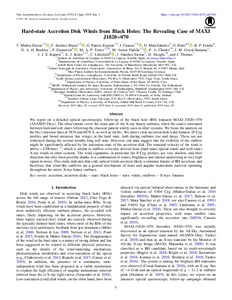Hard-state Accretion Disk Winds from Black Holes: The Revealing Case of MAXI J1820+070
Munoz-Darias T; Jimenez-Ibarra F; Panizo-Espinar G; Casares J; Sanchez DM; Ponti G; Fender RP; Buckley DAH; Garnavich P; Torres MAP; Padilla MA; Charles PA; Corral-Santana JM; Kajava JJE; Kotze EJ; Littlefield C; Sanchez-Sierras J; Steeghs D; Thomas J; Thomas J
Hard-state Accretion Disk Winds from Black Holes: The Revealing Case of MAXI J1820+070
Munoz-Darias T
Jimenez-Ibarra F
Panizo-Espinar G
Casares J
Sanchez DM
Ponti G
Fender RP
Buckley DAH
Garnavich P
Torres MAP
Padilla MA
Charles PA
Corral-Santana JM
Kajava JJE
Kotze EJ
Littlefield C
Sanchez-Sierras J
Steeghs D
Thomas J
Thomas J
IOP PUBLISHING LTD
Julkaisun pysyvä osoite on:
https://urn.fi/URN:NBN:fi-fe2021042821373
https://urn.fi/URN:NBN:fi-fe2021042821373
Tiivistelmä
We report on a detailed optical spectroscopic follow-up of the black hole (BH) transient MAXI J1820+070 (ASASSN-18ey). The observations cover the main part of the X-ray binary outburst, when the source alternated between hard and soft states following the classical pattern widely seen in other systems. We focus the analysis on the He I emission lines at 5876 and 6678 angstrom, as well as on H alpha. We detect clear accretion disk wind features (P-Cyg profiles and broad emission line wings) in the hard state, both during outburst rise and decay. These are not witnessed during the several months long soft state. However, our data suggest that the visibility of the outflow might be significantly affected by the ionization state of the accretion disk. The terminal velocity of the wind is above similar to 1200 km s(-1), which is similar to outflow velocities derived from (hard-state) optical winds and (soft-state) X-ray winds in other systems. The wind signatures, in particular the P-Cyg profiles, are very shallow, and their detection has only been possible thanks to a combination of source brightness and intense monitoring at very high signal-to-noise. This study indicates that cold, optical winds are most likely a common feature of BH accretion, and therefore, that wind-like outflows are a general mechanism of mass and angular momentum removal operating throughout the entire X-ray binary outburst.
Kokoelmat
- Rinnakkaistallenteet [27094]
